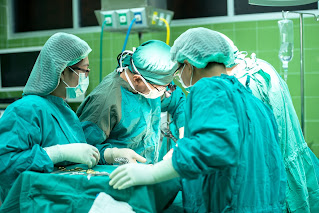Brain
death
What is brain death? I think you may know about it.
In this blog I’m just briefing about what is it? And what is the diagnosis?
Brain death is an irreversible one. Once you get
your brain dead then you will be dead slowly by terminating each part of your
body. If you have a loss of function of entire cerebrum and brain stem then you
will be in coma. Then you will have no spontaneous reaction and loss of
reflexes.
Diagnosis:
The patient will be diagnosed by
· serial
determination of clinical criteria
· Apnea
testing
· Sometimes
EEG, brain vascular imaging
If you are declaring brain death structural and
metabolically cause of brain damage must be present.
If the patient has suspected an epileptics then EEG
should be done.
You should observe the
patient and do examinations on the patient.
Examination includes:
· Assessment
of pupil reactivity
· Assessment
of occulovestibular, occulocephalic, and cornea reflexes
· Apnea
testing
For examination we need
the equipment Reflex hammer, flashlight, cotton-tipped swab, tongue depressor,
60ml syringe, kidney basin, ice cold water, towel roll, arterial blood gas,
oxygen source, T-piece, Suction catheter.
If we need to know the
person is in brain dead we need to do the examination of patient:
If patient is in coma check the diagnosis:
To examine the patient we need to check the stimulus or automatic response for the body like if we keep pen in between toes press against the toe in the abnormal condition the foot will not remove but in normal condition you will remove the foot.
Pain full nail beds response if the patient is in normal by applying pressure to any of the nail beds then you will remove the hand but in the abnormal condition you will not remove the hand by applying the pressure. And also you need to check the pupilary response to the stimulus.
Interrogate brainstem
Check the pupillary
response: in normal condition you will observe that the constriction in
response to the flashlight but in the abnormal there will be no any
constriction of pupil
a. b.
But in certain
conditions is difficult in assessing pupillary response like:
1.
Pre-existing pupillary abnormalities –
Coloboma
2.
By administrating of certain medications
to the eye –Atropine or phenylephrine
3.
Trauma to the eye
Corneal reflex: by
taking cotton-tipped swab touch the cornea if your eye blinks then the patient
is in normal condition if not then the patient is in abnormal condition.
Oculocephalic
maneuvers: observe the patient eye can maintain mid line position when the head
turned and should never perform this test in patients with known or suspected
cervical spine injury. But in this case if he/she is not maintaining same
position then the patient is in abnormal condition.
Oculovestibular
reflexes: To do this test you need to put head of the bed in 30 degrees so you
can have semicircular canals orthogonal to gravity. Since it is a good idea
that we are about put water in to bed and put towel to out of the basin. The
fill the basin with cold water. Then we would take into syringe 50cc’s of cold
water. Before going further you need to check there is no wax in the ear and no
pathology that we would prevent the test. Then hold back the eye lids. Then place
the basin beside the ear insert the syringe tube(attach any IV tube to the
syringe). And as rapidly install 50ml of ice water into the otic canal and
observe the eye stimulus if the eye is moving more towards cold water stimulus
and less towards opposite then the patient is in normal condition. If the
patient eye is moving only towards the cold water then the patient is having
brainstem response but no cortical response. If the patient eye is not
responding then he/she having neither brainstem response nor cortical response.
Note: after installing
cold water into the ear you may need to wait 90-120seconds. To observe the
response before concluding that there is no response.
Difficult in evaluating
oculovestibular reflex:
1.
Cerumen ( in otic canal) will prevent
the cold water reaching from the typhanic membrane
Oropharyngeal response:
we can this by any tongue blade or any cotton swab by keeping deep in to the
mouth and you will observe elevation of palatal but in the abnormal patient you
will see no response from the musculature in retropharyngeal area.
Apnea test: to observe
this apnea test first we need to give oxygen to the patient by the ventilator
through the T-piece, and disconnect from ventilator and ensure that the oxygen
level >85% and B.P remain 5 percentile to the age. And observe for a period
of 5-10 min so that PaCO2 would raise at least 20mm of mercury
·
Note: if the O2 level fall
below 85% or BP fall below the limit then the test discontinue.
·
Before reconnecting to the ventilator
draw arterial blood gas
·
If ABG demonstrates PaCO2
> 60mmHg then the apnea test is positive. Then appear for second clinical
exam
If you have not seen
the breathing for 5-10 min the connect to the ventilator before it draw the
arterial blood gas and wait for ABG test
If the test shows
increase at least 20mmHg of PaCO2 and the level is greater than
60mmHg: the child haven’t breathed to that stimulus.
Note: if the PaCO2
level is < 60 do not diagnose brain death
Some experts told that
the threshold should rise higher than a PaCO2 level of 60mmHg
Conclusion : if you
like this blog please support us and if they are any mistakes feel free to
comment it. share and follow us












